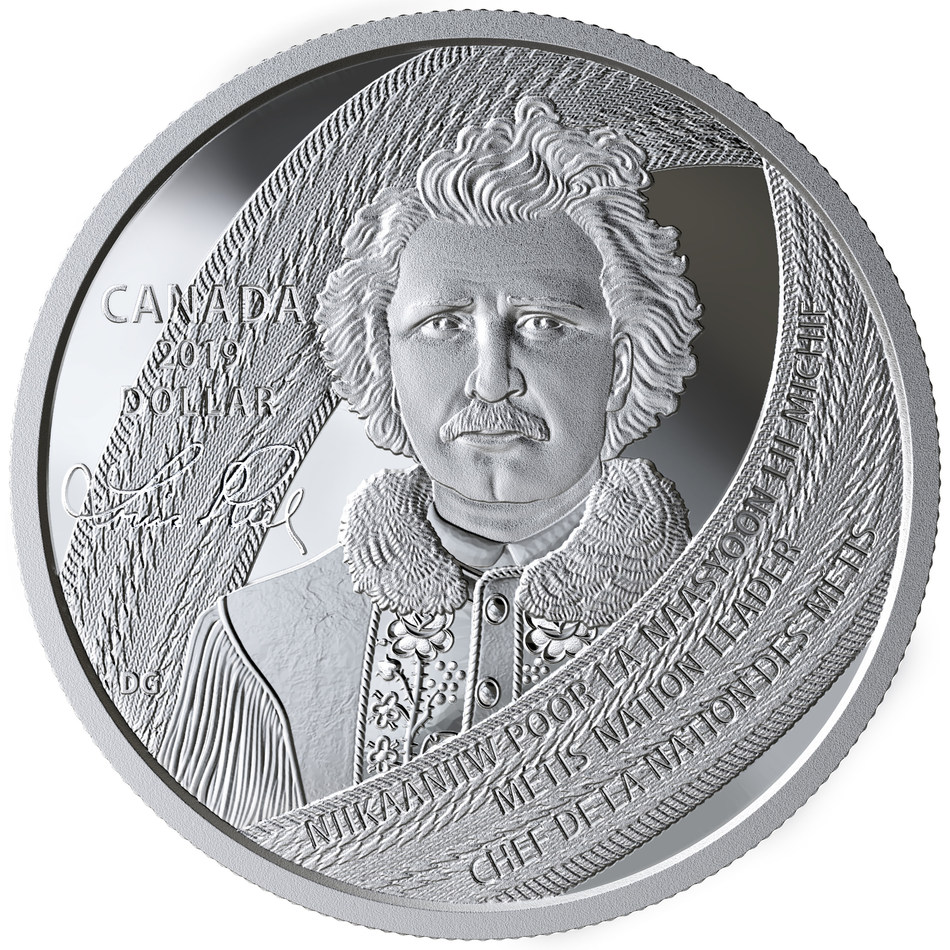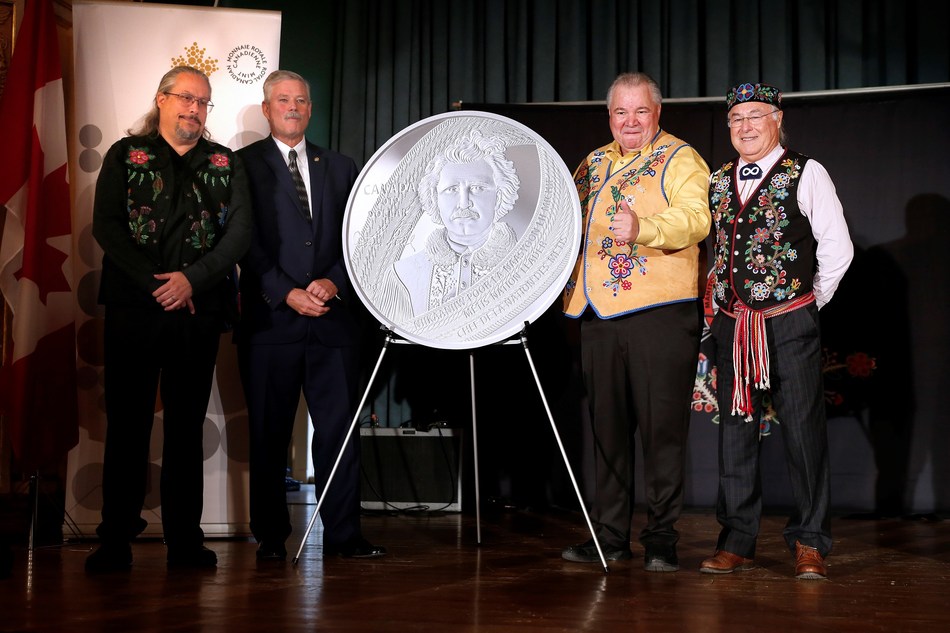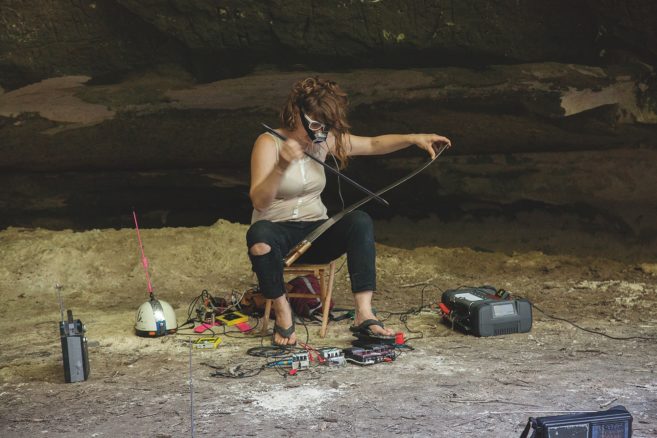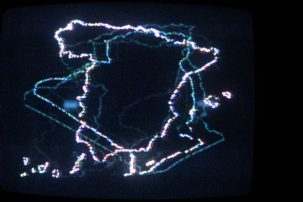On October 22nd, the Royal Canadian Mint, in partnership with the Manitoba Metis Federation (MMF) and the Métis National Council (MNC) unveiled a new silver dollar commemorative coin featuring Louis Riel, the (in)famous Métis leader of two 19th-century anticolonial resistances in response to Canadian incursion into Métis lands. Seen variously as a visionary leader of the Métis and traitor to Canada, Riel was charged with treason and hanged by the Canadian state in 1885. Métis armed resistance on the prairies was brutally crushed in the service of Euro-Canadian colonialism and driven by the capitalist imperatives of resource extraction and export that continue to undergird and legitimize Canada’s presumed rule in the West.
The coin features a portrait of Riel in a beaded and fringed buckskin jacket in the foreground, and a ceinture fléchée weaving—a type of colourful sash—around him and across his chest, inscribed with the Michif, English and French languages. Many, both Indigenous and non-Indigenous peoples, are celebrating the coin as an important form of representation for the “Forgotten People.” For a people whose primary relationship with Canada has been one of state demonization and neglect, recognition of this kind can absolutely feel like a victory, and it is important not to discount the affective benefits of mainstream representation. However, now more than ever, as the federal government looks to address its relationship with the Métis through this and other forms of recognition, resources and programs, it is crucial that we turn a critical eye to whether and to what extent initiatives like the Riel coin actually serve and honour Métis history and contemporary realities as an autonomous and self-determining Indigenous people, or whether, on balance, they continue and even intensify Canada’s attempts to subordinate and disappear us into its body politic.
Riel as Capital
What does it mean when we have allowed one of our greatest leaders to be transformed into the capital of the state that murdered him by hanging him for treason to squash the North-West Resistance? Aside from being a rather ghoulish project, in the most basic sense a commemorative coin is non-circulating legal tender, which means that while you are unlikely to receive it as change when you buy a bag of chips, for example, it is legally worth its dollar value and can be put toward that bag of chips if you so choose (and at the discretion of the cashier). Its value as tender is equivalent to and based on the Canadian dollar. Riel’s image, of the man himself and as a symbol of the Métis Nation, can now pay the social workers that remove Indigenous children from our families with devastating frequency; can pay the salaries of officers of the RCMP, the same anti-Indigenous paramilitary that was created (as the North-West Mounted Police) to quell Indigenous resistance to Canadian invasion of our territories and that continues to criminalize, brutalize and surveil our people; can pay the Canadian corporation–funded death gangs that terrorize, enslave, rape and murder Indigenous people around the world in the service of mineral extraction. Although Riel’s likeness may not literally change hands in these transactions, by tying ourselves symbolically and discursively to Canadian capital through the Riel coin, Métis become more deeply implicated in these and other abuses while our capacity to intervene in them continues to be constrained. It is representation with no accompanying shift in power.
Riel’s image, of the man himself and as a symbol of the Métis Nation, can now pay the social workers that remove Indigenous children from our families with devastating frequency. …It is representation with no accompanying shift in power.
Currency also functions in part as a nearly ubiquitous form of nationalist symbolism that tells a particular kind of story about the state that produces and circulates it. Who or what is chosen to be stamped onto a coin or printed onto a bill contributes to patriotic narratives that are reified through these physical manifestations and reproduced again and again through capitalism. Money passing through your hands in exchange for goods and services isn’t just a medium of transaction: it is the repeated legitimization of the story that Canada tells about itself or, maybe to put it more accurately, the repetition of the story of legitimacy that Canada tells about itself. National narratives have the power not only to shape our perceptions of history—they become the context that informs and structures everything from educational curricula to political and economic policy to the state’s reputation internationally to its assumed authority and sovereignty over Indigenous lands and peoples.
Riel as Canadian
What is the narrative that Canada promotes with the Riel coin? The Royal Canadian Mint, in its statements about the coin, claims that its purpose is to highlight “the contributions of Louis Riel (1844–1885), and those of the Métis Nation, to the story of Canada,” and that when it comes to the Métis, this aspect of history is a “tale of two nations whose histories are intertwined.”
These statements manage to flatten the complex cultural, governance and intellectual traditions of the Métis people; the nature of two anticolonial guerrilla resistances fought by politically and militarily powerful allied Indigenous nations against the Canadian dominion; and a century and a half of subsequent dispossession and immiseration into contributions to the story of Canada. The Métis people, our history and our nationhood come to be represented by one man notable, through this narrative, primarily for how his life and work impacted the state that would execute him and colonize his people. And while our nations’ histories are, indeed, intertwined, this phrasing obscures the vast power differential that structures the colonial relationship between Canada and the Métis Nation. The Mint goes on to assert that the coin exists “in the recognition of a founding people’s sacrifices,” transforming our ancestors’ struggles to retain our homes, lands and lifeways in the face of violent Canadian invasion into a “sacrifice” on the altar of colonial progress for the good of Canada (of which the Métis are now a part, whether we like it or not). In essence, the Royal Canadian Mint is saying, “It wouldn’t be the same Canada we know and love without your bloody defeat at our hands. Thanks, have a coin.”
 The Royal Canadian Mint’s silver collector coin commemorating Louis Riel. Courtesy CNW Group/Royal Canadian Mint.
The Royal Canadian Mint’s silver collector coin commemorating Louis Riel. Courtesy CNW Group/Royal Canadian Mint.
Even a cursory critical reading of the Canadian description of the Riel coin makes plain that, while the coin was created nominally to represent the Métis, it actually comes to represent Canada’s narratives of who the Métis are and what is significant about the Métis to the Canadian colonial project. This is an issue with the framing of the coin itself, as well as with the focus on Riel as the quintessential Métis—a celebrity and political patriarch whose life comes to define who Métis are, never mind that our people existed before him and (contrary to standard mainstream histories) continue to exist as a distinct people after his hanging. Métis have wildly varying and complex understandings of Riel, our history, the resistances, our culture and our governance, and how best to articulate all of those things. Canada has stolen those complexities and twisted them to fit a neat and palatable narrative that assumes Canadian priority and legitimacy over Métis nationhood.
For the Métis, whose interests have been ignored, neglected and excluded by the colonial state for more than a century, proper and respectful representation can work against decades of anti-Métis conditioning that has denigrated our culture and lifeways. But we must be cautious, aware and critical of how our symbols are taken up and mobilized, especially by the colonial power that continues to constrain and circumscribe our capacity as a self-determining people. We need control over not just how we are being represented—we need to be able to ensure we are telling the narrative behind the symbol our way and in ways that promote good relations with our fellow Indigenous nations and good relations among ourselves. If the Riel commemorative coin is to have any real value at all, it is to show us the limits of representation without systemic change.

 From left: Artist David Garneau, Royal Canadian Mint Senior Director of Manufacturing Tom Roche, Manitoba Metis Federation President David Chartrand and Métis National Council President Clement Chartier unveil a silver collector coin celebrating the 175th anniversary of the birth of Louis Riel in Winnipeg, Manitoba on October 22, 2019. Courtesy CNW Group/Royal Canadian Mint.
From left: Artist David Garneau, Royal Canadian Mint Senior Director of Manufacturing Tom Roche, Manitoba Metis Federation President David Chartrand and Métis National Council President Clement Chartier unveil a silver collector coin celebrating the 175th anniversary of the birth of Louis Riel in Winnipeg, Manitoba on October 22, 2019. Courtesy CNW Group/Royal Canadian Mint.







